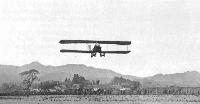
Описание
Страна: Япония
Год: 1915
Single-engine tractor biplane
R.Mikesh, A.Shorzoe Japanese Aircraft, 1910-1941 (Putnam)
Itoh Aeroplane Research Studio (ltoh Hikoki Kenkyusho)
The Itoh Aeroplane Works came into being on 30 January, 1915. It was his enthusiasm for and love of flying that prompted Otojiro Itoh to become involved with aviation and eventually to create his own aircraft manufacturing company. This is in sharp contrast to other aircraft companies in Japan whereby the more prominent ones had their beginnings with military contracts that assured success. Never a large company or builder of aircraft in quantity, Itoh was one of the earliest prominent companies and the first established aircraft manufacturer in Japan.
While employed as a young man by the Sadoshima Copper and Iron Company in his hometown of Osaka, Otojiro Itoh became inspired with flight when seeing the Wright brothers' success in a film. He wrote to the Japanese aviation pioneer Sanji Narahara, asking him what was needed to get into the field of aviation. He was advised that he should have schooling in mechanical engineering and Itoh diligently obeyed by attending night school.
At the age of 19, in 1910, ltoh left home and moved to Tokyo where he worked as a mechanic at the Narahara aeroplane company. Impressed with his eagerness and interest in aviation, Narahara made ltoh an assistant to Einosuke Shirato, who had worked exclusively for Narahara as a pilot. This association was interrupted when Itoh reached the age of 20 because, like all other young Japanese men, he was conscripted for a one year term of service in the military. Upon returning to Narahara in 1912, he assisted in the manufacture of the aeroplanes and accompanied demonstration flights around Japan as a ground crewman.
As spare-time employment, ltoh assisted Shigesaburo Torigai with the manufacture of the Torigai Hayabusa-go Aeroplane which eventually crashed in September 1913. ltoh borrowed this aeroplane, quit his job and moved with the aeroplane to Inage, on Tokyo Bay just north of Chiba City. There he made repairs and modifications to the aeroplane, and began to learn to fly with the help of two others. The sandy beach there proved an excellent runway, but its availability was dependent upon the height of the tide. After three months of flying training, maintaining and repairing his own aircraft, he had accumulated a total of a mere 3 hours of flying.
Pilot licences, or, for that matter, any regulations concerning flying and aeroplanes were yet to come. Therefore, Itoh established a flying school on the beach at Inage in February 1915, and called it the ltoh Kyodo Hiko Renshusho (Itoh Co-operative Flight Training Ground). The ltoh Aeroplane Research Studio and Training Ground were both known to the public as ltoh Airfield. For flying training, he used the Torigai Hayabusa-go Aeroplane after it had been modified. To supplement his income, Itoh joined part time with Shirato, formerly with the Narahara company, who now was building his own aeroplanes. This added income allowed ltoh to begin his commercial construction of aircraft and by the autumn of 1915 he completed his first; the Itoh Emi I.
Itoh Emi 1 Aeroplane
This was the first aeroplane built by the young aviator Otojiro Itoh, assisted by Toyokichi Daiguchi, Toyotaro Yamagata, and a hired carpenter. The work was begun in September 1915 and the aeroplane was flown for the first time on 11 November that year at Inage Beach. The engine was the French-designed 45hp Gregoire Gyp purchased in August 1914 from Shigesaburo Torigai.
The aeroplane was a three-bay biplane with fabric-covered wooden structure and four-wheel undercarriage. Since today's common dope was not then available, primer paint was mixed with gelatine and Formalin, and external 'paint' was paraffin dissolved in petrol. The cost of building this aeroplane was about 400 yen, plus 1,200 yen for the engine, extremely cheap when compared to equivalent imported aeroplanes then costing over 10,000 yen.
This was a time when there were few prepared airfields other than Tokorozawa Army Base. Aviation events normally took place on Army parade grounds, racecourses and dry river beds. Undercarriages had to be designed with sufficient strength for take off and landings from rough surfaces, and normally consisted of twin dual wheels and skids. Ground transport between events was normally by rail, and therefore the airframes were designed for ease of assembly and disassembly as well as repair.
Overcoming these difficulties, Itoh made a daring flight on 8 january, 1916, from his base at Inage Beach to Tokyo, a distance requiring 55 minutes' flying, making this event the first flight by a civil aeroplane to Tokyo. This was the first of fifty-eight cities which he visited to demonstrate his aeroplane and create air mindedness in Japan. This was the second successful japanese-made civil aeroplane, following the Narahara 4 Ohtori-go Aeroplane.
The success of the Emi 1 was not only due to Itoh's excellent design but also to his own flying ability. To express his appreciation to sponsors in Ebisu-cho, Osaka, where he was born, he named his aeroplane Emi-go (Emi and Ebi are the same when written in Kanji) and continued to use this name for his aircraft. Later the Emi 1 was used by Masaaki Fujiwara who replaced the engine with a 50hp Hino Type engine and used it for flying training at Inage.
Single-engine tractor biplane. Wooden structure with fabric covering. Pilot in open cockpit.
35-45hp Gregoire Gyp four-cylinder water-cooled inline engine, driving a two-bladed wooden propeller.
Span 11.50m (37ft 8 3/4in); length 6.65m (21 ft 9 3/4in); height 2.50m (8ft 2 1/2in); wing area 33sq m (355.22sq ft).
Empty weight 350kg (771lb).
Maximum speed 41kt (47mph).
One built in 1915.
- R.Mikesh, A.Shorzoe Japanese Aircraft, 1910-1941 (Putnam)
Фотографии
-
R.Mikesh, A.Shorzoe - Japanese Aircraft, 1910-1941 /Putnam/
Itoh Emi 1 Aeroplane

